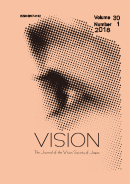
- Issue 4 Pages 233-
- Issue 3 Pages 117-
- Issue 2 Pages 69-
- Issue 1 Pages 1-
- |<
- <
- 1
- >
- >|
-
Ichiro Kuriki, Satoshi Nakadomari, Kenji Kitahara2003 Volume 15 Issue 4 Pages 233-244
Published: 2003
Released on J-STAGE: April 19, 2019
JOURNAL FREE ACCESSWe conducted a series of tests on color vision for a patient with simultaneous agnosia after cortical damage from cerebral anoxia (hypoxic encephalopathy). He suffered from shape perception in the wide range of visual area; he could perceive only a small part of an object at a time. He showed regular performance in color vision tests, such as panel D-15 test, or color naming tests under D65 simulating fluorescent lamp with and without colored glasses (color-constancy test). However, he showed extremely strong colorcontrast effect. We conducted a precise psychophysical experiment to investigate the characteristics of his color-contrast effect. He made achromatic adjustments so that the center color patch had almost the same chromaticity as its surround. These results suggest that his regular performance in the color-constancy test could have been realized by the use of local chromatic-contrast signal between the edge of target and its surround, with higher priority than normal observers.
View full abstractDownload PDF (5233K) -
Rika Kaneko, Yoshiki Fukunaga, Takatsune Kumada2003 Volume 15 Issue 4 Pages 245-254
Published: 2003
Released on J-STAGE: April 19, 2019
JOURNAL FREE ACCESSWe examined age-related changes in target identification when task-irrelevant stimulus was presented in the periphery. We measured choice reaction time (RT) for a Gabor patch (target) tilted right or left on the fixation while another Gabor patch (distractor) was simultaneously presented to the right or left of the target. The directions of the target and distractor were consistent or inconsistent. The distance between the centers of the target and distractor was 1.5, 3.0, or 4.5 degrees, and was fixed within a block of trials. Mean RTs in inconsistent conditions were longer than those in consistent conditions for older and younger adults. The difference between the mean RTs in the consistent and inconsistent conditions was greater for older adults than for younger adults when the distractor was presented in the closest distance. These results suggest that aging affects the inhibitory process of task-irrelevant stimuli.
View full abstractDownload PDF (4180K) -
Keiji Uchikwa, Kenshirou Kato, Kenji Yokoi, Hirohiko Kaneko2003 Volume 15 Issue 4 Pages 255-260
Published: 2003
Released on J-STAGE: April 19, 2019
JOURNAL FREE ACCESSIt was previously mentioned that a surface viewed by a stereoscope with binocular disparity might appear differently in color than when it was originally observed in two dimensions. In the present research we investigated whether brightness and/or chromaticness of a surface changed when it appeared with depth in a stereoscopic space. Test and matching stimuli were presented side by side on a CRT screen. These stimuli appeared in the surface-color mode except the yellow stimulus. The test stimulus was presented with front, back and 0 disparity from the standard plane, whereas the matching stimulus always appeared with 0 disparity. The observer adjusted luminance and chromaticities of the matching stimulus in order to obtain color-matching between the test and the matching stimuli. The results show that when the test stimulus appeared in front it looked brighter than at the standard position, and that when it appeared at back it looked almost the same. We proposed a color constancy hypothesis to explain the present results.
View full abstractDownload PDF (2670K)
-
Akiyoshi Kitaoka, Hiroshi Ashida2003 Volume 15 Issue 4 Pages 261-262
Published: 2003
Released on J-STAGE: April 19, 2019
JOURNAL FREE ACCESSDownload PDF (1555K) -
[in Japanese], [in Japanese], [in Japanese]2003 Volume 15 Issue 4 Pages 263-266
Published: 2003
Released on J-STAGE: April 19, 2019
JOURNAL FREE ACCESSDownload PDF (1844K)
-
[in Japanese]2003 Volume 15 Issue 4 Pages 267
Published: 2003
Released on J-STAGE: April 19, 2019
JOURNAL FREE ACCESSDownload PDF (512K)
-
2003 Volume 15 Issue 4 Pages 268-269
Published: 2003
Released on J-STAGE: April 19, 2019
JOURNAL FREE ACCESSDownload PDF (518K)
- |<
- <
- 1
- >
- >|